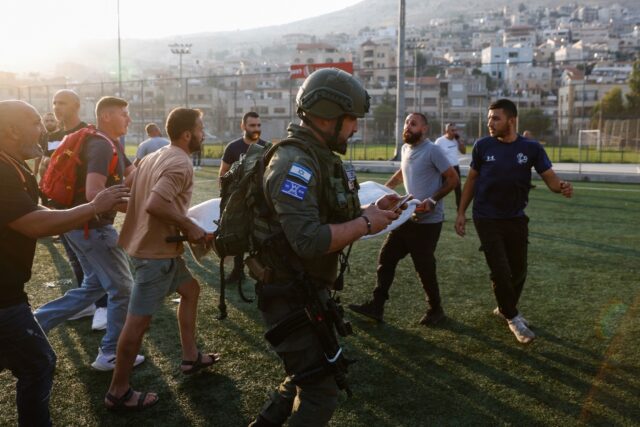The health ministry in Hamas-run Gaza said an Israeli strike on a school killed 30 people Saturday, while a rocket fired from Lebanon killed 12 youngsters in the Israeli-annexed Golan Heights.
Israel’s military said Hezbollah fired the rocket from Lebanon, hitting a football pitch in the Druze town of Majdal Shams and killing the youngsters, who were between 10 and 20 years old.
Another 18 youths were wounded in the attack, said the emergency services.
“Israel will not let this murderous attack go unanswered and Hezbollah will pay a heavy price for it, a price it has not paid before,” said Prime Minister Benjamin Netanyahu, according to a statement from his office.
Israeli forces and Hezbollah have traded cross-border fire since early October, following the attack by the Lebanese group’s ally Hamas on southern Israel which sparked the war in Gaza.
Netanyahu later said he would hold a security cabinet meeting on his return to Israel from the United States.
The United Nations urged “maximum restraint”, in a joint statement from their special coordinator for Lebanon, Jeanine Hennis-Plasschaert, and UN Interim Force in Lebanon (UNIFIL) chief Aroldo Lazaro.
Intensifying exchanges of fire “could ignite a wider conflagration that would engulf the entire region in a catastrophe beyond belief,” they said.
The US National Security Council condemned what it described as a “horrific attack”.
“Our support for Israel’s security is iron-clad and unwavering against all Iranian backed terrorist groups, including Lebanese Hezbollah,” a spokesman said in a statement.
The European Union’s foreign policy chief Josep Borrell condemned the “bloodbath” and called for an independent investigation.
Hezbollah denial
Hezbollah had earlier claimed several attacks on Israeli military sites after an air raid on southern Lebanon killed four of its fighters. But it denied it was responsible for the deadly strike on Majdal Shams.
“The Islamic Resistance has no connection to this incident,” it said, referring to its military wing.
But Israeli military spokesman Rear Admiral Daniel Hagari said in a statement early Sunday: “The rocket fired by Hezbollah was a Falaq 1 Iranian rocket, carrying a 50-kg warhead.
“This is a model that is owned exclusively by Hezbollah.”
At least 25,000 Israeli settlers live in the Golan Heights, along with at least 23,000 Druze — who traditionally follow an offshoot of Shiite Islam and remained on the land after Israel captured it.
Hours after the killings in Majdal Shams, a Lebanese security source said an Israeli drone fired two missiles at the village of Taraiyya in eastern Lebanon.
The strikes destroyed a hangar and home, without causing casualties, the source told AFP on Sunday.
Deadly school strike
The latest strike on a school in Gaza came after a days-long military operation further south that killed around 170, said emergency services there.
The health ministry reported “30 martyrs and more than 100 wounded” in the strike on Khadija school in the central Deir el-Balah area.
Israel’s military said Palestinian militants were using the compound as a “hiding place”.
The latest Gaza strike, which Israel said targeted “terrorists”, was at least the eighth time since July 6 a school has been hit.
The strikes have killed more than 100 people, based on figures given by the health ministry and a hospital source.
With most of the Gaza Strip’s 2.4 million people displaced at least once during the war started by Hamas’s October 7 attack, many have sought refuge in school buildings including the one hit on Saturday.
Further south, in the Khan Yunis city area, around 170 people have been killed “and hundreds wounded” in an Israeli operation since Monday, Gaza’s civil defence agency said.
It issued the toll after the military warned of new operations in the Khan Yunis area, where troops had earlier recovered the bodies of five Israelis killed during the October 7 attack and held in Gaza since.
Aid effort ‘destabilised’
Israel had warned on Monday that its forces would “forcefully operate” in the Khan Yunis area.
On Saturday, the military ordered residents from more parts of Khan Yunis “to temporarily evacuate to the adjusted humanitarian area in Al-Mawasi” — the second such change to the declared safe zone within a week.
The United Nations said that by Thursday, more than 180,000 Palestinians had already fled fierce fighting there.
Mahmud Bassal, spokesman for the civil defence agency, told AFP that many people had been displaced again on Saturday as the Israeli operation continued.
But with large parts of Khan Yunis “not suitable for living” and “no other options available”, civilians have struggled to find safety, he said.
“Where will these residents go?”
The evacuation orders and “intensified hostilities” have “significantly destabilised aid operations”, the UN said, reporting “dire water, hygiene and sanitation conditions” in the Palestinian territory.
Khan Yunis was left devastated after heavy fighting early in the year but the military withdrew in April.
Now it has returned in force. Israel said on Friday that its forces had “eliminated approximately 100” militants in Khan Yunis during the week.
‘End this madness’
The October 7 attack on southern Israel resulted in the deaths of 1,197 people, mostly civilians, according to an AFP tally based on official Israeli figures.
Militants also seized 251 hostages, 111 of whom are still held captive in Gaza, including 39 the military says are dead.
Israel’s retaliatory military campaign in Gaza has killed at least 39,258 people, according to Gaza’s health ministry, which does not provide details of civilian and militant deaths.
Egyptian state-linked media said Egyptian, Qatari and US mediators are to meet with Israeli negotiators in the latest push for a Gaza truce, which critics of Netanyahu have accused him of blocking.
The latest mediation efforts have focused on a ceasefire and hostage release accompanied by increased aid flows into besieged Gaza and the freeing of Palestinian prisoners held by Israel.

COMMENTS
Please let us know if you're having issues with commenting.